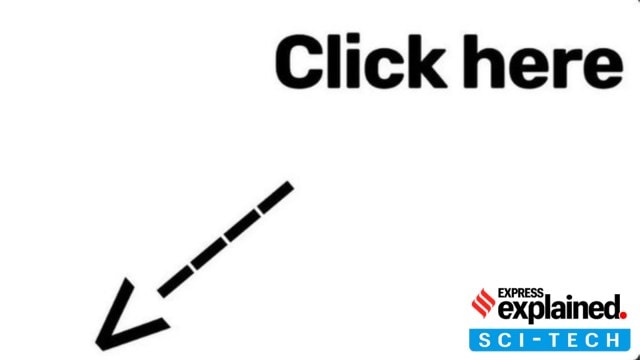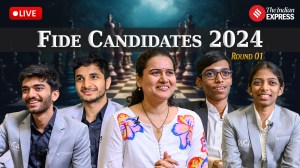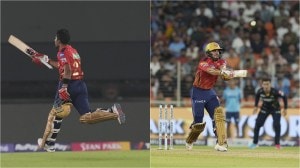- India
- International
What is the ‘Click here’ trend on X, and why has it been criticised?
The social media trend uses the Alt text feature to make jokes, but what exactly is this function? Why has this trend been criticised by some people with visual impairment?
 The trend sees accounts on X posting rectangular photos with a white background and black text saying “Click here”. (X.com)
The trend sees accounts on X posting rectangular photos with a white background and black text saying “Click here”. (X.com)What’s common between the BJP, Congress, AAP, and the European football clubs Barcelona and Paris Saint-Germain (PSG)? All these major accounts have hopped on the “Click here” trend on the social media platform X (formerly Twitter).
While the trend first garnered global attention last year, it is witnessing another round of virality now. What exactly is it, and why have some criticised it? We explain.
What is the Click here trend on X or Twitter?
Accounts on X post rectangular photos with a white background and black text saying “Click here”. An arrow points to the bottom left corner of the photo. When a user clicks on the post, a small box appears, with the word “ALT” written on it. On clicking this, a text box opens up.
 The BJP’s click here post on X. (Screengrabs)
The BJP’s click here post on X. (Screengrabs)
In the BJP’s case, it says the party’s Lok Sabha election slogan in Hindi: “फिर एक बार मोदी सरकार” (Modi government once again). Accounts across X have used it to make jokes, while brands and organisations have used it as a marketing tool to spread their taglines or slogans.
Any user can make their photos have an ALT box accompany them, and add to it whatever text they want. When selecting and posting an image for posting it on X, the edit option provided can be used for adding text.

So what exactly is Alternative or Alt text?
X says: “You can add a description, sometimes called alt-text, to your photos so they’re accessible to even more people, including people who are blind or have low vision. Good descriptions are concise, but present what’s in your photos accurately enough to understand their context.”
This works along with another crucial technology that improves accessibility for persons with visual impairment. Mobile phones come equipped with screen readers, which are applications that allow an automated voice to read out contents on a screen — messages, numbers, the names of apps, and so on.
For instance, on a Samsung phone, going into Settings and then to the Accessibility section shows the TalkBack option. Switching it on means a user can control their phone through voice commands or understand what is written on the screen. However, as a Samsung message acknowledges, it is “appropriate for apps that help you with accessibility needs, but not for most apps.”
Through a screen reader, a person with visual impairment can read the alt text accompanying a photo to understand what it shows. On its blog, X gave an example. Say there is a post of a field with clouds, and a user has captioned it “Coolest clouds I’ve ever seen.” Here, the user can add a descriptive alt text when posting the photo: “A field of wildflowers in the background with clouds overhead.”
X, Meta and most major websites are alt text enabled.
Beyond the accessibility, writing alt descriptions for online images posted anywhere is thought to help Google understand the overall content of that webpage. This improves Search Engine Optimisation (SEO) for a website, meaning that the article posted by creators has a higher chance of appearing as a top result on Google Search.
Google says, “When writing alt text, focus on creating useful, information-rich content that uses keywords appropriately and is in context of the content of the page.”
What is the criticism against the Click here trend?
A 2023 BBC article noted the criticism against the trend when major brands such as McDonald’s and Red Bull shared it. It questioned the usage of accessibility technology for mainly sharing a meme among sighted people and disregarding its original purpose.
Since the alt text in these jokes was not describing the image but instead having some random information intended as a joke, it could lead to further confusion for people with visual impairment.
Conner Scott-Gardner wrote to McDonald’s: “Really disappointing to see your social media team completely disregard blind people and accessibility by misusing the alt text field like this. alt text is a necessary accessibility feature which gives blind people like myself access to visual content.” The fast food giant said he was right and later took down the post.
Scott-Gardner also told the BBC: “They’re only using that accessibility feature when it’s convenient to them and brings something to their sighted followers.”
The controversy also led to a discussion about the need for Internet content creators to add alt texts and spread the word about their intended use. A 2022 article in The New York Times said: “One analysis of a million homepages, by WebAIM, a nonprofit organization affiliated with Utah State University that focuses on web accessibility, found that as of February 2021, 60.6 percent had instances of missing alt text. A Carnegie Mellon study in 2019 of 1.09 million tweets with images found that only 0.1 percent of those tweets included alt text. (The New York Times has been working on rolling out alt text for its images.)”
More Explained
EXPRESS OPINION
Apr 05: Latest News
- 01
- 02
- 03
- 04
- 05































